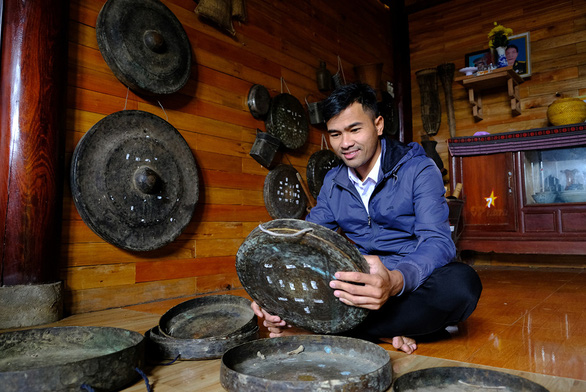A young Ca Dong person who yearns to keep the musical heritage of his community alive, 32-year-old Dinh Van Sieng from Son Tay District of the central province of Quang Ngai went on a quest to collect pieces of traditional gongs and cymbals -- the emblems of his culture.
After years of work, the Ca Dong archivist built up a small museum for himself, which also doubles as a community space for admirers of the culture found in the Central Highlands of Vietnam.
Pieces of identity
After returning home from military service in 2010, Sieng realized many of the instruments and household appliances of Ca Dong people were being superseded by alternatives from the majority Kinh people: indigenous rattan baskets were being phased out for plasticwares.
The most depressing thing for Sieng is to see the gongs and cymbals, considered the souls of the land, are being sold with only some being kept by older generations in the village.
They are also the last one to keep the indigenous craft of making gongs and cymbals to play in important festivals.
According to Sieng, before he left for the army, gongs were everywhere in the village, with some families keeping sets of hundreds-year-old pieces.
The instruments were brought out in every community gathering, sounding rhythms and timbre that raise the spirit of Ca Dong people.
Tunes from the gongs were played at official festivals of the Ca Dong community, including the harvest festival, buffalo sacrifice festival, new year celebrations, and heaven worshipping rituals.
A symphony of gongs, cymbals, Krau strings, and folk songs of Ra Nghe, Kalieu was one of the most captivating draws for tourists coming to Quang Ngai.
“Yet only two years later, most families don’t keep gongs and cymbals anymore," Sieng said,
"Festivals without them are dispiriting.
"Kinh people visiting the locale are also upset."
Seeing the cultural heritage of his community waning, Sieng set out to seek the last pieces of gongs and acquire them with his own money.
He did not face much hardship convincing the owners to sell as the struggling Ca Dong households are in dire need of money to live by.
“Getting rid of culture and identity means eternal destitution," he remarked.
"People come to this land for its unique customs and practices.
"If we don’t keep it, no one will bother being here."
His first purchase was a set of 12 cymbals from a senior leader in a nearby village, for which he paid VND15 million ($650) using his savings from the army days.
Bringing the newly-acquired cymbals home, he ruffled his wife and mother as they could not understand whether the pieces could be of any realistic use.
However, the purchase came as a delight to his father, who promptly contributed six cymbals from his well-kept collection to Sieng and asked him to let the heritage live on.
“By now, [I think] my father in heaven can be proud of what I have done,” Sieng said as he is carrying on his father’s wishes.
Small museums, big dreams
At this time, Sieng’s hometown of Son Tay is welcoming flocks of visitors seeking 'cloud-hunting' and photography opportunities at the breathtaking view of the Mang Hin terraced field and from the top of Ca Ra Mount looking down to the verdant patches of transplanted rice seedlings.
Another must-visit in visitors’ itineraries is Sieng’s gallery, which overlooks a terraced field and exhibits hundreds of Ca Dong cultural items.
The collection provides a panoramic snapshot of the heritage of Ca Dong people.
“I have heard a lot about Sieng’s collection, but one must see it to believe it. It’s amazing,” said Do Minh Hung, a photographer from nearby Da Nang who visited Sieng’s gallery.
The building itself is also a sophisticated work: it took Sieng two years to complete the smallest details in the wood structure and strip off the old roofing to build a second floor.
He also put thought into the floor plan and item arrangement for them to best represent the legacy of Ca Dong culture.
Sieng is thrilled every time a visitor comes to his place.
“I envisioned a dedicated stilt house for exhibiting and vending coffee products, as well as for visitors to rest. People in the neighborhood can also bring their products there to sell to tourists,” Sieng said.
Once a lone ranger in his quest to preserve the heritage of his community, even facing rumors of selling his culture, Sieng has now become a well-known collector in the Ca Dong populace.
Knowing his good intention, many seniors of the community chose to gift him their treasured artifacts, such as baskets, crossbows, and string instruments.
Sieng is a spearhead figure of the community, who has inspired other youths to pick up the disciplines of making baskets, as well as playing gongs and traditional strings.
“Ten years ago, I feared that the art of playing gongs, strings, or singing Ca Dong folk tunes would be lost once the generation of my father is gone, but that doesn’t bother me anymore,” he said.
In recent years, many young people have dropped by Sieng’s house to borrow the gongs for festivals of ethnic minorities in Quang Ngai and the central region.
These events used to be attended by seniors of the community only.
“That alone was enough to be hopeful,” he said.
Like us on Facebook or follow us on Twitter to get the latest news about Vietnam!



























